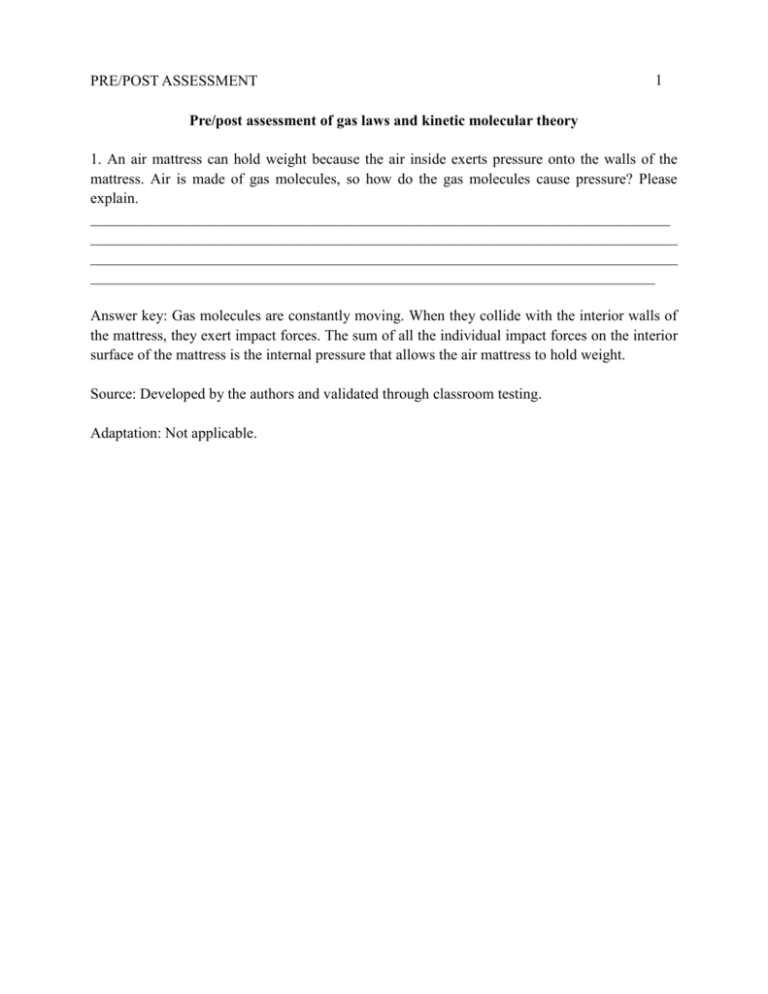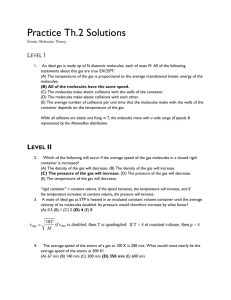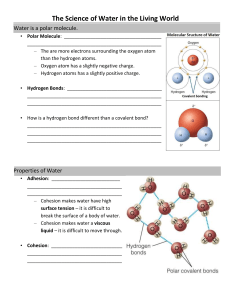PRE/POST ASSESSMENT Pre/post assessment of gas laws and
advertisement

PRE/POST ASSESSMENT 1 Pre/post assessment of gas laws and kinetic molecular theory 1. An air mattress can hold weight because the air inside exerts pressure onto the walls of the mattress. Air is made of gas molecules, so how do the gas molecules cause pressure? Please explain. _____________________________________________________________________________ ______________________________________________________________________________ ______________________________________________________________________________ ___________________________________________________________________________ Answer key: Gas molecules are constantly moving. When they collide with the interior walls of the mattress, they exert impact forces. The sum of all the individual impact forces on the interior surface of the mattress is the internal pressure that allows the air mattress to hold weight. Source: Developed by the authors and validated through classroom testing. Adaptation: Not applicable. 2 PRE/POST ASSESSMENT 2. A steel tank is filled with hydrogen gas at a temperature of 20°C and a pressure of 3 atm (atmospheres). In the following diagram, the circle represents the tank, and the dots represent the distribution of hydrogen molecules. If the tank is cooled to 5°C, hydrogen still remains a gas. Which of the following diagrams illustrates the distribution of hydrogen molecules at 5°C? a) b) c) d) Please explain your choice for question 7-Part I: ______________________________________________________________________________ ______________________________________________________________________________ ______________________________________________________________________________ ______________________________________________________________________________ _________________________________________________________________________ Answer key: A. Gas molecules are randomly distributed in the space they occupy as long as they remain in the gaseous state. Source: (Sanger & Phelps, 2007) Adaptation: We reworded the question stem to accommodate for the average reading ability of high school students. The original question asked about the distribution of hydrogen gas molecules when the temperature is lowered to -20°C. As Sanger and Phelps indicated, many students mistakenly believed that hydrogen gas would turn liquid at that temperature, and their misunderstanding led them to choose the wrong alternatives. To eliminate this irrelevant factor, we changed the condition on temperature to “cooled to 5°C” and also explicitly indicated that hydrogen still remains a gas at 5°C. 3 PRE/POST ASSESSMENT 3. A scientist filled a steel container with air and sealed it so that no air would leak out. She measured the pressure inside the container in the morning when it was cold and then in the afternoon when it was hot. She found that the pressure increased a lot. Please explain what happened to the gas molecules causing the pressure to increase. Feel free to draw to help you explain. _____________________________________________________________________________ ______________________________________________________________________________ ______________________________________________________________________________ ___________________________________________________________________________ Morning Afternoon Answer key: When temperature increases in the afternoon, the gas molecules inside the steel container move faster on average and have greater kinetic energy on average. Because of their increased speeds and kinetic energy, they collide with the walls of the container more frequently with greater impact forces. The increased collision frequency and the greater impact force of each collision both cause the gas pressure to increase. Source: Developed by the authors and validated through classroom testing. Adaptation: Not applicable. 4 PRE/POST ASSESSMENT 4. A flask is closed by a stopper connected to a glass tube. The glass tube is sealed by a drop of mercury as shown in the following figure. If we move the whole apparatus from a room with a temperature of 26 °C to an outdoor yard with a temperature of 5 °C, and the indoor air pressure and the outdoor air pressure is the same, what will happen to the mercury drop? a) The mercury will not move. b) The mercury will move to the right. c) The mercury will move to the left. d) It is impossible to predict. Explain your prediction: _____________________________________________________________________________ ______________________________________________________________________________ ______________________________________________________________________________ ______________________________________________________________________________ __________________________________________________________________________ Answer key: C. When the apparatus is moved to the colder outdoor yard, the gas molecules in the flask will move slower, thus they collide with the flask less frequently with less force, resulting in a lower internal pressure. As the atmospheric pressure stays the same, there will be a net force pushing the mercury drop toward the flask. Source: (Lin & Cheng, 2000) Adaptation: We added two alternatives “the mercury will not move” and “it is impossible to predict” as they are plausible and attractive distractors. 5 PRE/POST ASSESSMENT 5. After being cooled to 5°C, the pressure inside the steel tank (described in question 2) described in question 7A will be: a) 0 atm b) In-between 0 atm and 3 atm c) 3 atm d) Greater than 3 atm Please explain your choice: ______________________________________________________________________________ ______________________________________________________________________________ ______________________________________________________________________________ ______________________________________________________________________________ _________________________________________________________________________ Answer key: B. As the temperature decreases, the gas molecules inside the steel tank move slower with lower kinetic energy. Because their slower speeds and lower kinetic energy, they would collide with the walls of the container less frequently with weaker impact forces, resulting in a decrease in gas pressure. However, gas pressure will not go down to 0 atm because they are always moving as long as the temperature is above absolute zero. Source: (Sanger & Phelps, 2007) Adaptation: We added this question as a supplement to question 2 to see how students relate gas pressure and the distribution of gas molecules. 6 PRE/POST ASSESSMENT 6. When you pump your bicycle tires, the air pump feels harder and harder to push as you push in. Please explain what happen to the gas molecules inside the pump and how they make it harder to push. _________________________________________________________ _________________________________________________________ _________________________________________________________ _________________________________________________________ _________________________________________________________ _________________________________________________________ _________________________________________________________ _________________________________________________ Answer key: There are two mechanisms that make it harder to push as you pump a bicycle tire. First, as more gas molecules enter the tire, the frequency of collision between gas molecules and interior wall of the tire increases, resulting in higher gas pressure. Second, as you push down the pump, the volume of the gas decreases, which also makes gas molecules collide with the tire more frequently, resulting in higher pressure. Source: Developed by the authors and validated through classroom testing. Adaptation: Not applicable. 7 PRE/POST ASSESSMENT 7. The evening before a birthday party, you fill several balloons with helium gas. The birthday party occurs on a hot summer day. The next day (the same hot temperature and the same atmospheric pressure) the latex balloons are noticeably smaller. Which of the following explains this observation? a) b) c) d) The molecules moved closer to each other. The helium molecules lost their strength. Some of the helium molecules escaped through pores in the latex. The helium molecules became smaller than before. Please explain your choice: _____________________________________________________________________________ ______________________________________________________________________________ ______________________________________________________________________________ ___________________________________________________________________________ Answer key: C. According the gas laws, the volume of a gas is determined by its temperature, pressure, and quantity. As the temperature and the pressure of the gas stays the same, it must be a decrease in the quantity of the gas that caused the volume of the gas to decrease. At the molecular level, gas molecules are constantly moving and colliding with the interior of the latex balloons. As latex is a porous material, it is possible for gas molecules to penetrate through it and escape to the atmosphere. Source: Matter Concept Inventory-v5 (American Modeling Teachers Association, n.d.) Adaptation: We added a prompt for students to explain their choices. 8 PRE/POST ASSESSMENT 8. Two containers of the same size are at the same temperature. One contains 1 mole of hydrogen gas, and the other contains 1 mole of nitrogen gas. The mass of nitrogen molecules is greater than that of hydrogen molecules. Which of the following statements is true? a) b) c) d) The pressure of the hydrogen gas is higher than that of the nitrogen gas. The pressure of the hydrogen gas is lower than that of the nitrogen gas. The hydrogen gas and the nitrogen gas have the same pressure. It is difficult to tell. Please explain your choice: _____________________________________________________________________________ ______________________________________________________________________________ ______________________________________________________________________________ ___________________________________________________________________________ Answer key: C. According to the gas laws, the pressure of a gas is determined by its temperature, volume, and quantity. Molecular mass of a gas has no impact on its pressure. At the molecular level, with the same temperature, heavier gas molecules move slower than lighter gas molecules, but they have greater momentum due to their greater mass. As a result, heavier gas molecules collide with the container walls less frequently than lighter gas molecules, but their collisions were more forceful than the lighter ones. These two aspects cancel out each other, resulting in the same pressure on the container walls. Source: Developed by the authors and validated through classroom testing. Adaptation: Not applicable. 9 PRE/POST ASSESSMENT 9. A mixture of 0.5 moles of hydrogen gas and 0.5 moles of chlorine gas in a container at 300 K has a total gas pressure of 98.8 kPa. If the hydrogen gas is taken out and only the chlorine gas remains in the container, what would the pressure be? Explain your answer. _____________________________________________________________________________ ______________________________________________________________________________ ______________________________________________________________________________ ______________________________________________________________________________ __________________________________________________________________________ 1. Answer key: In a mixture of gases, each gas has a partial pressure which is the hypothetical pressure of that gas if it alone occupied the volume of the mixture at the same temperature. The total pressure of an ideal gas mixture is the sum of the partial pressures of each individual gas in the mixture. The partial pressure of a component gas is proportional to its quantity. Thus, the hypothetical pressure of the chlorine gas is half of the total pressure of the mixture. At the molecular level, the reason why molecular mass has no impact on gas pressure is similar to that for question 8. Source: Developed by the authors and validated through classroom testing. Adaptation: Not applicable. PRE/POST ASSESSMENT References 10 American Modeling Teachers Association. (n.d.). Matter Concept Inventory, version 5. Retrieved from http://modelinginstruction.org/researchers/evaluation-instruments/ Lin, H., & Cheng, H. (2000). The assessment of students and teachers’ understanding of gas laws. Journal of Chemical Education, 77(2), 235–238. Sanger, M. J., & Phelps, A. J. (2007). What are students thinking when they pick their answer? A content analysis of students’ explanations of gas properties. Journal of Chemical Education, 84(5), 870–874.









